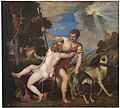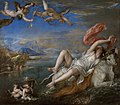The Rape of Europa (Titian)
| The Rape of Europa | |
|---|---|
 | |
| Artist | Titian |
| Year | ca. 1560–1562 |
| Medium | Oil on canvas |
| Dimensions | 178 cm × 205 cm (70 in × 81 in) |
| Location | Isabella Stewart Gardner Museum, Boston |
The Rape of Europa is a painting by the Venetian artist Titian, painted ca. 1560–1562. It is in the permanent collection of the Isabella Stewart Gardner Museum of Boston, Massachusetts. The oil-on-canvas painting measures 178 by 205 centimetres (70 in × 81 in).[1]
Subject[edit]
The title of the painting refers to the mythological story of the abduction of Europa by Zeus (Jupiter to the Romans).[1] In the myth, the god assumed the form of a bull and enticed Europa to climb onto his back. Once there, the bull rode into the sea and carried her to Crete, where he revealed his real identity. Europa became the first Queen of Crete, and had three children with Zeus. When Zeus finally departed Crete, he gifted her three parting gifts, a necklace, a javelin, and a bronze guard.
Titian is unequivocal about the fact that this is a scene of rape (abduction): Europa is sprawled helplessly on her back, her clothes in disarray.[2] Furthermore, the position of legs indicates that she is kicking and fighting and attempting to free herself from Zeus. The painting depicts Europa on the back of the bull, just off the shore of her homeland. Her attendants in the background are wearing the same pink garment that Europa has in her hands.
Although the source of Titian's inspiration is thought to have been based on the scene from Book II in Ovid's Metamorphoses, a more direct influence might be a description of a painting of the rape of Europa found in Achilles Tatius's novel, Leucippe and Clitophon. Achilles Tatius's novel was translated into Italian and printed in 1546 in Venice, only a few years before Titian was thought to have painted The Rape of Europa.[3] Achilles Tatius's description of the dolphins, Europa's scarf, a Cupid, Europa's covering, and "her position on the back of the bull—not with a leg on each side but with her feet on the bull’s right side and her left hand on his horn" is echoed in Titian's portrayal of the same scene.[4] Ovid's translation, notes the color of the bull and the postion of her body, on the bull. "His color is like snow[5] and "Muscles bulge around his neck". This is similar to the physical details Titian shows.
Scholarly Interpretation[edit]
Although the act of sexual violence is not depicted in the painting, it is implied through Europa's open-legged posture and her expression of fear as she is dragged off by Zeus.[6] Her danger is also implied by her waving a red silk scarf and by the sea monster in the foreground of the painting.[7] In other parts of the painting, two putti in the sky chase after Europa, and one rides on a dolphin in the sea.[7]
Yael Even has theorized that Titian could have created this painting not due to any particular attachment to the subject, but in order to assert his abilities as a painter.[8]
Provenance[edit]
The painting was one of the "poesie" painted by Titian for Philip II of Spain. With Diana and Callisto and Diana and Actaeon, both now shared by London and Edinburgh; it was one of three Titian poesie given by Philip V of Spain to the French ambassador, the Duke of Gramont, who in turn presented them to Philippe II, Duke of Orléans, Regent of France from 1715 to 1723.[9] For most of the 18th century it was in the Orleans Collection in Paris.[10] It was purchased by Bernard Berenson on behalf of art collector Isabella Stewart Gardner in 1896.[11]
Titian's poesie series for Philip II[edit]
- Danaë, delivered to Philip 1553, now Wellington Collection, with earlier and later versions.
- Venus and Adonis, Museo del Prado, delivered 1554, and several other versions
- The Rape of Europa, c. 1560–1562, Isabella Stewart Gardner Museum
- Diana and Actaeon, 1556–1559, owned jointly by London's National Gallery and the National Gallery of Scotland in Edinburgh
- Diana and Callisto, 1556–1559, owned jointly by London's National Gallery and the National Gallery of Scotland in Edinburgh
- Perseus and Andromeda, Wallace Collection, c. 1553–1562
- The Death of Actaeon, National Gallery, never delivered and not always counted in the series, c. 1559 onwards
-
The Rape of Europa
Exhibitions[edit]
The painting was included in the 1857 Manchester Art Treasures exhibition.[12] From August 12, 2021, to January 2, 2022, the Isabella Stewart Gardner Museum displayed all six Titian poesie in an exhibit titled Titian: Women, Myth & Power.[13] It was the first time since the 16th century that the six paintings were physically united.[14]
See also[edit]
Further reading[edit]
- FitzRoy, Charles, The Rape of Europa: The Intriguing History of Titian's Masterpiece, London: Bloomsbury, 2015.
- Silver, Nathaniel, ed., Titian's Rape of Europa, Boston, Massachusetts: Isabella Stewart Gardner Museum, 2021.
References[edit]
- ^ a b "Europa". Isabella Stewart Gardner Museum. Retrieved 20 August 2014.
- ^ Stephen J. Campbell, "Europa," in Eye of the Beholder, edited by Alan Chong et al. (Boston: ISGM and Beacon Press, 2003): 103–107.
- ^ Stone, Donald (1972). "The Source of Titian's Rape of Europa". The Art Bulletin. 54 (1): 47–49. doi:10.2307/3048932. ISSN 0004-3079. JSTOR 3048932.
- ^ Stone, Donald (1972). "The Source of Titian's Rape of Europa". The Art Bulletin. 54 (1): 48. doi:10.2307/3048932. ISSN 0004-3079. JSTOR 3048932.
- ^ Ovid (2015-11-12), "Metamorphoses, Translation of Book 1", The Vulgate Commentary on Ovid's Metamorphoses, Medieval Institute Publications, pp. 1–22, retrieved 2023-11-17
- ^ Eaton, A.W. (2003). "Where Ethics and Aesthetics Meet: Titian's Rape of Europa". Hypatia. 18 (4): 161. doi:10.2979/HYP.2003.18.4.159. JSTOR 3810979 – via JSTOR.
- ^ a b "The Rape of Europa | Isabella Stewart Gardner Museum". www.gardnermuseum.org. Retrieved 2020-10-26.
- ^ Even, Yael (2001). "Commodifying Images of Sexual Violence in Sixteenth-Century Italian Art". Source: Notes in the History of Art. 20 (2): 16, 17, 18. doi:10.1086/sou.20.2.23206799. JSTOR 23206799. S2CID 192994296 – via JSTOR.
- ^ Brigstocke, Hugh. Italian and Spanish Paintings in the National Gallery of Scotland, p. 183, 2nd ed., 1993, National Galleries of Scotland, ISBN 0-903598-22-1
- ^ FitzRoy, Charles. The Rape of Europa: The Intriguing History of Titian's Masterpiece, London: Bloomsbury, 2015, ISBN 9781408192092
- ^ Saltzman, Cynthia (2008). Old Masters, New World: America's Raid on Europe's Great Pictures, 1880-World War I. Viking. p. 77. ISBN 978-0-670-01831-4.
- ^ Hamilton, James (2015). A Strange Business. New York, NY: Pegasus Books. p. 325. ISBN 978-1-60598-870-2.
- ^ Titian: Women, Myth & Power
- ^ Smee, Sebastian, "Titian Comes Together," The Washington Post, August 19, 2021, updated August 21, 2021







